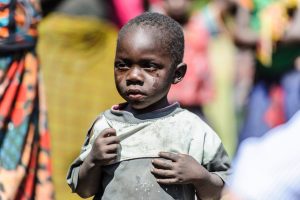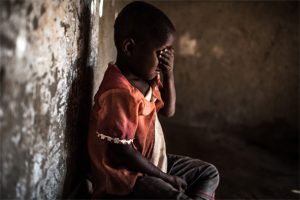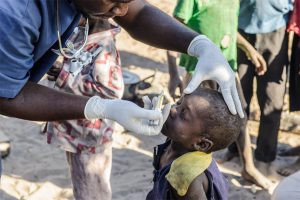We met Barbara Abbruzzese, Corporate Fundraiser of Sightsavers Italia Onlus.
Your association has a wonderful mission: "Our vision is of a world where no one is blind from avoidable causes and where people with disabilities are an active part of society". Would you like to tell us how Sightsavers came about and talk about your activity in the world?

Sightsavers was founded in 1950 by Sir John Wilson: blind since the age of 12, during a trip to Africa he realised that there was a very high number of blind people on that continent and that these people lived in terrible conditions because they were considered unable to do anything. He therefore decided to set up an organisation to help the world's poorest countries on two fronts. On the one hand, the prevention and treatment of eye diseases: even today, 75% of blind people would not be blind if they had access to existing treatments and operations. On the other hand, the inclusion of blind and visually impaired people through inclusive education for children, mobility and orientation courses, vocational training for adults and many other activities: what Sir John Wilson wanted was to eliminate discrimination against visually impaired people and to enable them to have an independent and fulfilling life, enjoying equal rights.
Almost 70 years later, thanks to Sir John's initiative, more than 10.2 million eye operations have been performed, more than 183 million people have been visited, and more than 1.14 billion medicines against neglected tropical diseases have been distributed. In other words, the future of millions of people has been completely transformed and all thanks to the initiative of a man and his wife, who believed in this project so much that they mortgaged their own house to start it and dedicated their entire lives to it.

Could you tell us how the problem of cataracts, the leading cause of blindness in the world, is addressed and managed in the contexts where Sightsavers is present?
The first obstacle to be tackled in the fight against this disease is the widespread ignorance about the operation to restore sight: many people do not even know the operation exists or are afraid of it because of popular beliefs and superstitions. It is therefore necessary to reach even the most remote communities, to raise awareness by spreading all the necessary information, to carry out check-ups, to help those who have difficulty in reaching health facilities, to train surgeons, to equip operating theatres, to finance the operation for those people - and they are the majority - who cannot afford it, and to carry out check-ups. In other words, ours is an all-round intervention.
Could you give us some figures on the number of people who, without surgery, would have been at risk of going blind precisely because of unoperated cataracts?
In 2018 alone we performed over 355,000 cataract operations, almost 40,000 more than the year

previous: this helps to get an idea of the scale of the emergency. Not only is there a large backlog of surgeries in developing countries that is not easy to clear, but cataracts are also set to grow over time due to the ageing and growing world population. Moreover, in poorer countries, it also affects children, sometimes from birth, preventing the development of the visual neurological system, which means that if action is not taken in a timely manner, vision may be compromised forever.
What projects are currently running that have the greatest impact on children?
Our projects generally address people of all ages, but there are some specifically dedicated to children. I am referring, for example, to our work to ensure quality education for all children with disabilities, so that they can build their future together with their peers. Another project which is particularly close to my heart and which I have had the opportunity to visit personally means that in some districts in India, all schoolchildren, from 5 to 17 years old, are examined and given glasses if they have refractive errors; if they have any other problem with their eyesight, they are referred to facilities where they can receive the further care they need. This is basically changing the future of an entire generation and, thanks to community awareness, of subsequent generations as well.
Why is the fight against trachoma such an important goal for Sightsavers and how does your commitment fit in with the WHO campaign?

Trachoma is a devastating disease that has been destroying the lives of people affected by it for thousands of years. It is a bacterial infection that is transmitted from person to person and through flies. Repeated infections leave scars on the inside of the eyelids causing them to contract and turn; the eyelashes then begin to grow inwards and scratch the eyes with every blink, damaging the cornea. At that point, if no action is taken, blindness sets in in a slow and very painful agony. About two million people worldwide are blind or visually impaired due to trachoma and 157 million are still at risk. But the extraordinary thing is that this terrible infection can be defeated today thanks to a strategy endorsed by the World Health Organisation, the mapping of the disease that we conducted a few years ago, and the collaboration with local governments and other organisations committed to this great challenge. Eliminating trachoma means not only transforming the lives of those affected, but having an incalculable impact on the future of humanity, which will finally be rid of a devastating scourge. A historical result made possible only thanks to supporters like SIFI, who believe in this initiative and have chosen to support it with great generosity.
What kind of relationship does Sightsavers have with the governments of the countries in which it operates?
Sightsavers works with governments in the countries where it works and, through its policy and advocacy team, carries out activities with them to influence their initiatives in the areas of health and inclusion of people with disabilities. Our goal is for each of these countries to gradually become autonomous in the management of effective eye health systems and for people with disabilities to truly enjoy equal rights.
What resources do you use to finance and support your activities and projects?
Financial support for our work comes from very different sources: we are supported by other charitable organisations, governments, individuals through donations or legacies, foundations, companies. For our part, we are committed to using the donations we receive efficiently and this has enabled us, for the third year running, to be included among the 8 "Top Charities" of the world selected by GiveWell: an important guarantee for those who choose to support our work.
We close with a direct message from you to our readers:
"The 75% of blindness is avoidable: incredible, isn't it?
Sometimes an antibiotic costing just a few cents is enough to save a child from blindness.
In the countries where we work, losing one's sight can mean the difference between living and not surviving, and it still means a life of poverty and marginalisation ahead.
Poverty, in fact, is both cause and effect of blindness: you become blind because you are too poor to care for yourself and, once blind, you are unable to generate an income, and so you enter a spiral from which it is virtually impossible to escape.
L'impact for persons to whom the view is saved or returned is incalculableas it is for their families. That is why every single help can really making a difference and completely transform the life of someone on the other side of the world, bringing light and hope back into their future.
And for this we are so grateful to SIFI and those who, every day, decide to stand by us."
To support the work of Sightsavers you can make a donation by bank transfer in the name of Sightsavers Italia Onlus, Banca Intesa S.p.A., IBAN IT10H03069096061000001732, BIC/SWIFT BCITITMM or online at www.sightsavers.it
For English speakers see the pdf
See also
Ocular chlamydia and antibiotic therapy
Dr. Carmelo Chines
Direttore responsabile
